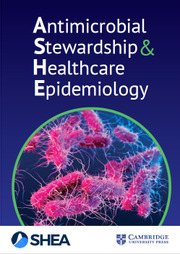No CrossRef data available.
Article contents
Using the POCT real-time PCR to detect Clostridium difficile in the environment to reduce the healthcare association infection
Published online by Cambridge University Press: 03 September 2025
Abstract
Introduction: To avoid Clostridium difficile infection in the healthcare facility is an important work. There were many methods to do in the C. difficile infection (CDI) reduction bundle, including cleaning and disinfection. After cleaning and disinfection, we can do an environmental examination to check whether it contains C.difficile or not. Traditional, we did the culture to check but it have to wait 24-48 hours. This method was so slow, so in this study, we try to use the molecular methodology to detect C.difficile. Methods: We collected the specimen after 16 hours when the cleaning and disinfection. Then we used the POCT real-time PCR((POCKIT central C.difficile, GeneReach Biotechnology Corp, Taiwan)) and culture agar to detect whether C.difficile is present or not. In this study, we collected 48 specimens from CDI patients’ environments when they transferred to another space or left. Results: We found all the POCT real-time PCR results were the same compared to the culture results. That’s to say, the POCT real-time PCR can replace the culture method and improve the term around time on the diagnosis of C.diffiicle. Conclusion: The molecular method could replace the traditional culture due to it was quick and precise. Patients can’t wait for the culture result in clinical, especially in the ICU. Once delayed, the mortality rate would arise. In other words, the POCKIT central C.difficile is useful in clinical. It can be used to detect whether C.difficile survives on the surface or not. However, due to the limitation of the sample count, the statistical significance was not complete. So we will collect the sample to finish this study.
Information
- Type
- Abstract
- Information
- Creative Commons
- This is an Open Access article, distributed under the terms of the Creative Commons Attribution licence (http://creativecommons.org/licenses/by/4.0/), which permits unrestricted re-use, distribution, and reproduction in any medium, provided the original work is properly cited.
- Copyright
- © The Author(s), 2025. Published by Cambridge University Press on behalf of The Society for Healthcare Epidemiology of America

